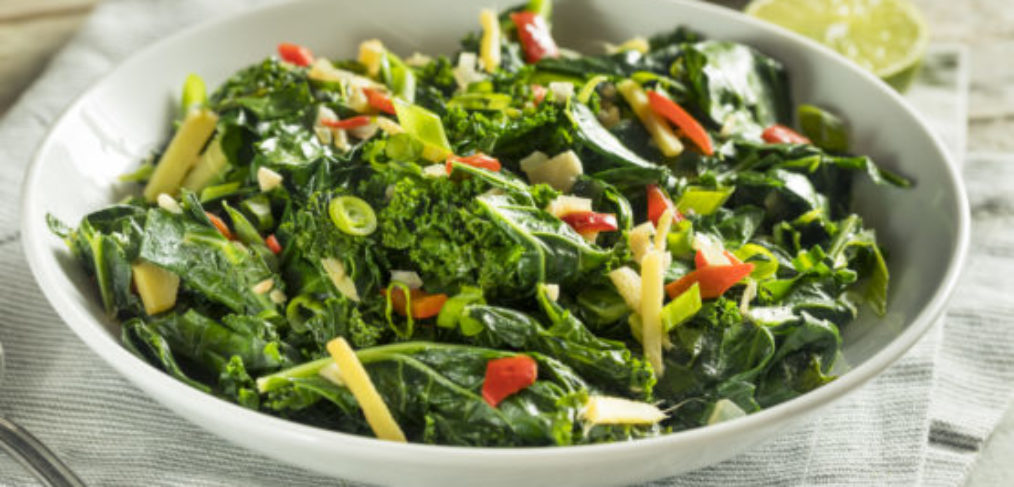Kale + Fat: What’s Wrong with That?

I’m a kale fanatic; anyone who knows me will vouch for this, and it goes way back to before kale was a thing.
Far before kale was cool, and for that matter, far before health food stores were cool, there you’d find me as a toddler with my hippie mom, purchasing the 70s versions of ‘health’ food including organic alfalfa sprouts, whole wheat flour for mom to bake her own bread, raw cashews (a favorite snack of mine that mom allowed me to have, despite the pediatrician warning her they might cause me to become a fat child), carob powder and Dr. Bronner’s all in one soap, amongst a plethora of other food + household stuff that are now the norm but back then, were just… weird.
Fortunately, I latched on to what she demonstrated and fell in love with real food and healthy eating around the time I was born, and rather than rebelling during the time I was a bratty teenager, I kept these things which were the foundation of healthy living close at heart, and continued eating these foods that others would often comment as being strange.
Including eating a bell pepper, whole and raw, as a snack (still don’t see what the big deal here is).
And, including eating kale.
One thing that has changed, thankfully, is the misconception that kale, and all veggies, while we’re on the subject, must be eaten only in their raw form or that if cooked, they must only be steamed if we want them to most easily maintain their status as being good for us.
Far from it.
Of course, we do lose nutrient density when we cook anything, but if we weigh out the pros and cons, one common reason people cite for not eating enough veggies is that they don’t like them.
Other variables apply, certainly, such as not carving out a small amount of time to prepare them, or not being sure of the best preparations of a veggie we’re trying out for the fist time but if we ditch the idea that our only two options in the veg department are raw or steamed, we open up a world of possibility.. and taste.
Most importantly, we can move forward, full speed ahead with one simple trick which can transform even the more boring of veggies to something undoubtedly decadent: add fat.
Simply put, you’ll never go wrong sautéing any veggie in coconut oil and garlic, or roasting it in duck fat with and capers, or blanching it then dousing it with olive oil and lemon.
As more and more people find themselves intrigued by a ketogenic approach to eating, whether or not they’re cycling into a paleo-inspired foundation of eating, slowly but surely, more fat-friendly veggie recipes and entrees at restaurants are popping up.
(To clarify, a properly executed ketogenic approach does not have to equal zero carbs and thus, zero veggies. The key is to be mindful of which veggies have the lowest net carbs and stick with those, making it easy to stay below 50 grams of carbs per day while cosuming adequate dietary fiber to keep the system running like clockwork).
Some of my own regular go-to recipes are my duck-fat roasted cauliflower and of course… sautéed kale.
Which is precisely why I loved an article published today in the Times’ food section, Where Kale Is King (at Least, When It’s Stewed in Schmaltz and Bacon) (1).
Who knew!?
It turns out that there is such a thing as an actual festival to celebrate this beloved leafy green, which ranks a 100 on the A.N.D.I. scale (2)!
In a corner of Germany some 50 miles south of the North Sea, kale is more than the essential ingredient for superfood smoothies or a better-for-you-than-broccoli vitamin bomb. It is a season, an event, a tradition.
Unlike the Bavarians’ annual beer festival, Oktoberfest, which is known the world around, the hikes and feasts surrounding the annual harvest of kale, grünkohl, in German, in the flat lands around Oldenburg and Bremen are unknown internationally and draw blank looks from most Germans.
A few years ago, the city of Oldenburg set out to change that. Calling itself the country’s “Kale Hike Capital,” it began promoting events surrounding the winter walks, held from November through late February.
I want to go!
I did detect a slight note of an apologetic nature when the preparation is reviewed; a long-cook or stew in bacon or goose fat and the reference to it being most delicious when eaten the next day, and I disagree that there’s any reason to not enjoy this preparation, again, so long as it’s balanced out with other means of preparing this, and other leafy greens.
Bring the fat on and own it.
When sourced properly, natural animal fats including pasture fed lard, grass fed tallow, duck fat, chicken schmaltz and you name which ever other ones you can recall your grandmother using, are a healthy part of our overall nutrient intake.
Products from grassfed animals offer us more than omega-3s. They contain significant amounts of two “good” fats, monounsaturated oils and stearic acid, but no manmade trans-fatty acids. They are also the richest known natural source of CLA and contain extra amounts of vitamin E and beta-carotene. Finally, grassfed meat is lower than feedlot meat in total fat and calories, making it ideally suited for the all too common sedentary lifestyle (3).
Sometimes sauté with lard; other times use coconut oil.
Sometimes roast in duck fat; other times add olive oil to steamed veggies after cooking.
Yet other times, simply cut an avocado in half, mash it up with some lime and dip in the raw veggies.
Find your own balance and get those veggies in somehow, and often!
One caveat: there is such thing as pushing it a little too far; if you’re attempting to count the bag of kale chips you munch on each day between that 9am latte and hasty fast food lunch at noon as part of your daily intake, don’t. Once in a while is one thing, but if that’s the only time something green graces your plate, consider including options that aren’t quite so highly processed as your regular go-to.
Stay tuned for an upcoming post discussing how healthy many of the new ‘healthy’ versions of snack foods are these days.
In the meantime, which veggies will you eat next?
(1) https://www.nytimes.com/2019/02/26/world/europe/germany-kale-festival.html
(2) https://www.drfuhrman.com/library/eat-to-live-blog/128/andi-food-scores-rating-the-nutrient-density-of-foods
(3) http://www.eatwild.com/articles/confused.html





